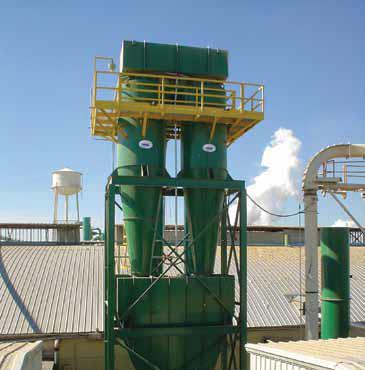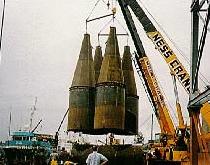Cyclones are used mainly to separate solids from liquid or gas streams. The hydrocyclone shown below is used to clean coal.

General Information
In general, cyclones use centrifugal force to separate particles in a gas or liquid stream. In hydrocyclones, the liquid is the fluid medium.
There are two design classifications for cyclones. Uniflow or swirl tube cyclones are designed so that the clean gas or liquid leaves the cyclone in the same direction that the inlet gas flows. Uniflow cyclones are often seen in series and do not contain a conical section. The dust simply exits the cyclone with a small portion of the inlet gas stream, about 5 – 10%.
Alternatively, reverse flow cyclones have a vortex reversal allowing the clean gas to exit at the top of the cyclone. Reverse flow cyclones usually stand alone and solid dust collects in the conical portion of the cyclone for removal. In reverse flow cyclones, contaminated liquid or dust-laden air enters tangentially near the top of the cyclone. Larger or heavier particles (the coarse) are thrown to the sides and slide to the bottom, where they are collected. The remaining air or liquid (the fines) reverses direction and spirals up the center of the cyclone and out the top.
Equipment Design
A tangential inlet is the most common type of inlet because it is the least expensive and most efficient. Additional inlet options are wrap-around, helical, and axial. Wrap-around inlets are best for high throughput designs and axial inputs are often seen in multi-cyclone configurations.
For a given particle size, a portion of the particles will exit out the bottom with the underflow, and the rest will exit with the overflow. The heavier the particle, the greater the chance that it exits out the bottom.
The cutpoint size, a measure of a cyclone’s performance, is defined as the particle size for which half the particles exit at the top and half at the bottom. A coarser (larger) cutpoint means that only larger particles can be separated. A finer (smaller) cutpoint means that smaller particles can be removed.
Cyclones can handle flow rates ranging from 3 gpm to over 10,000 gpm. Small-diameter cyclones may be manifolded to handle larger flow rates with higher efficiency. Cyclones can also be placed in series to handle streams with irregular particle sizes or with particles that tend to flocculate.
Usage Examples
Hydrocyclones are used in desliming, degritting, concentration, recovery of solids, clarification, open-circuit classification, and closed-circuit grinding. The hydrocyclone below is used to remove polypropylene powder from a solvent recovery unit.

Cyclones can recover powder coatings, dust, chemicals, and catalysts. The quad cyclone below is used to collect coal dust.

Cyclones are also commonly used to control particulate emissions and meet air quality standards. They can be designed to collect particles as small as 5 microns in diameter.
Advantages
- Low capital cost.
- High efficiency for 5 – 200 micron particles.
- High volume flow rate.
- Lack of moving parts reduces wear.
- Continuous or batch removal of underflow requires virtually no downtime for maintenance or recovery.
- Versatile application.
- Small relative to other separation equipment.
- Can operate at a wide range of temperatures and pressures
Disadvantages
- Reduced efficiency at less-than-capacity flow.
- Difficult to obtain good separation of substances of similar densities.
- Cannot handle the viscous flow.
- Extremely high velocities cause abrasive wear.
- Hydrocyclones cannot produce completely dry underflow.
- Clogging of the dust outlet is common in reverse flow cyclones
Acknowledgements
- Clean Gas Systems, Inc., Ronkonkoma, NY
- FLSmidth Inc., Denmark
- Mac Process Inc., Kansas City, MO; now part of Schenck Process
References
- Day, Roger W., and Charles N. Grichar. “Hydrocyclone Separation.” Handbook of Separation Techniques for Chemical Engineers, 2nd ed. Ed. Philip A. Schweitzer. New York: McGraw-Hill, Inc., 1988. Print.
- Dhodapkar, Shrikant V., and Heumann, William L., “Harnessing the Power of a Cyclone.” Chemical Engineering, 5(2011): 34 – 42.
- McCabe, Warren L., Julian C. Smith, and Peter Harriott. Unit Operations of Chemical Engineering. 5th ed. New York: McGraw-Hill, Inc., 1993. Print.
- Perry, Robert H., and Don W. Green. Perry’s Chemical Engineers’ Handbook, 7th ed. New York: McGraw Hill, 1997: 17-27 – 17-32. Print.
- Svarovsky, L. “Hydrocyclones.” Solid-Liquid Separation, 3rd ed. Ed. L. Svarovsky. London: Butterworth & Co. Ltd, 1990: 203-208, 210-214, 234-248. Print.
Developers
- Sam Catalano
- Joseph Palazzolo
- Matthew Robertson
- Steve Wesorick
- Kelsey Kaplan
- Andrea Roberts
- Henry Chen
